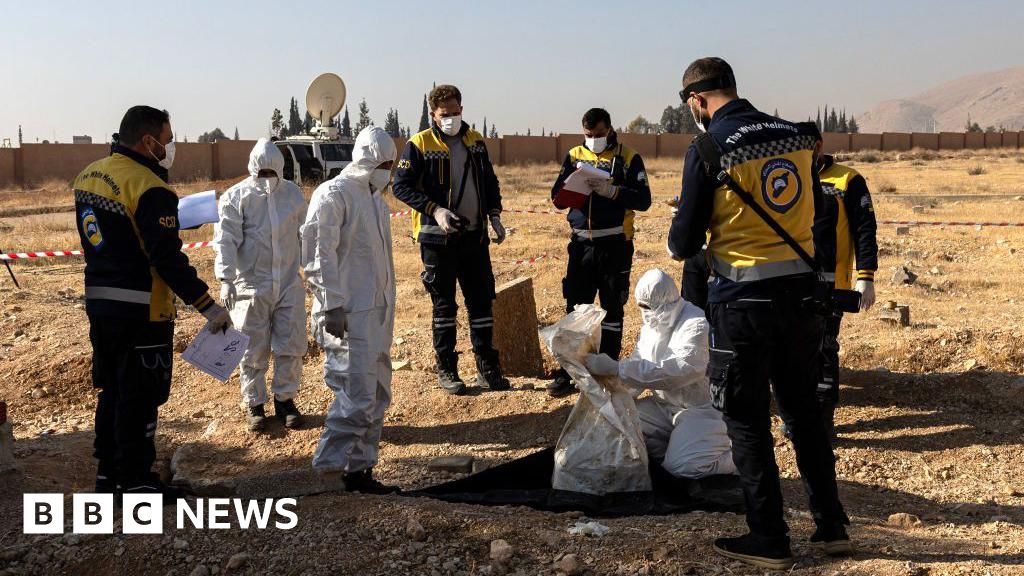 Getty Images
Getty ImagesLess than 10km (six miles) from the busy city centre of Damascus, in the north-western suburb of Adra, an arid stretch of land is sealed off with cement walls.
As you drive in, on the left-hand side, a team of rescuers from the White Helmets humanitarian organisation are seen searching for mass graves.
Over the past few days, videos have been posted online about mass graves where Bashar al-Assad’s regime buried those tortured to death in Syria’s notorious prisons.
In Adra, the White Helmets had found a small hole where several big white plastic bags were filled with remains of bodies.
A message simply reads: “Seven bodies, eighth grave, unknown.”
The team was pulling out the remains, skulls and bones, which they collected. DNA samples were put separately in black body bags for documentation and further analysis.
Ismael Abdullah, one of the rescuers, says they are carrying a heavy burden on their shoulders.
“Thousands of people are missing. It is going to take time – a lot of it – to get anywhere near the truth about what happened to them,” he says.
“Today, after receiving a call about possible mass grave here, we found on the ground the remains of seven civilians.”
He adds that all the necessary procedures were carried out “so in the future we can identify those people who were killed”. The team are among a small number who have been trained to document and collect forensic evidence.
 BBC/Thanyarat Doksone
BBC/Thanyarat DoksoneMore than 100,000 people are thought to have disappeared in Syria since 2011.
In the past week, the rebel group Hayat Tahrir al-Sham (HTS) – who ousted Assad after more than 50 years of his family’s rule – has opened up prisons and detention centres across Syria.
Rights group have concluded that more than 80,000 of the missing are dead. Another 60,000 people are believed to have been tortured to death, according to the UK-based war monitor the Syrian Observatory for Human Rights (SOHR).
Local people are reporting more and more locations of mass graves across Syria, and the Syrian Emergency Task Force (SETF), a US-based NGO, says that nearly 100,000 bodies have so far been found.
Rights group Human Rights Watch says such graves should be protected and investigated.
At another site in Qutayfah town, further to the north-west of Damascus, the SETF says thousands of bodies are believed to be buried in different mass graves.
One local resident, who witnessed the burial of bodies over the years of Syria’s civil war, says they were packed in refrigerated containers brought in by security forces.
The ground would be filled with bodies – and then the site would be flattened by bulldozers, he told the BBC.
 BBC/Thanyarat Doksone
BBC/Thanyarat DoksoneQutayfah’s religious leader Abdul Kadir al-Sheikha witnessed one such mass burial.
He was asked by secret police to come and manage the burial, he said. He tried to conduct the religious rituals for the dead and prayed for them.
He tells me that in these 30 sq m, at least 100 people were buried. After that he was never called in again by the police, he adds.
“They called them terrorists who didn’t deserve burial. They didn’t want anyone to witness what they were doing,” Mr Sheikha says.
The secret police prevented people from passing by mass grave sites or even looking out from their windows when they carried out the burial, another witness who was forced to take part told me.
Many such mass graves exist in the suburbs of Damascus, the witness said.
At another site in Husseiniyeh, on the road that leads to the Damascus airport, satellite images show differences in the landscapes of areas where mass graves have been discovered.
 BBC/Thanyarat Doksone
BBC/Thanyarat DoksoneAs the Assad regime crumbled in the face of the rebels’ rapid advance, thousands of Syrian families rushed to prisons and detention centres following to search for their missing loved ones.
They need closure and to honour their dead with a proper burial.
At one detention centre, hundreds of IDs of Syrians detained by Assad’s security forces were scattered on the ground.
One woman was still searching for her missing brother who disappeared in 2014. A father was looking for his son who was detained in 2013. No one is ready to give up the search.
But locating and protecting mass graves and identifying the bodies they contain are tasks that few Syrians are currently able to perform – and international experts are urgently needed to help with the process.



